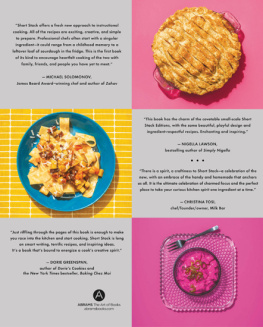


Despite the obligatory no smiling policy for Koreans taking pictures in the seventies, these photos show what was actually a very fun and festive sixtieth birthday party for my grandmother. (Shes in the yellow hanbok, the traditional Korean dress. Next to her, looking smashing in a ruffled orange and brown dress, is me!) My mother and grandmother spent days cooking for the party, and my father (the cool dude in sunglasses) hosted the party at our house in Seoul on a beautiful day in May.
INTRODUCTION
My first job in my grandmothers kitchen was to plate the banchan for the familys evening dinner. Some nights, it would only be two or three little dishes to go with fluffy steamed rice and doenjang jjigae, a soothing bowl of silky potatoes, soft tofu, and sweet squash stewed with the nutty Korean soybean paste. If we were having guests over or celebrating a birthday, I helped bring out the large black lacquered dinner table and filled it with homemade goodies: marinated steamed eggplant from the garden; soy-pickled perilla leaves I helped to harvest the week prior; pan-fried eggs rolled with diced vegetables; sun-dried radishes from last years harvest spiked with vinegar and fiery pepper flakes; and dried squid doused with honey and the chile paste called gochujang.
There might have also been japchae, glossy, slinky sweet potato starch noodles tossed with half a dozen vegetables; a whole fresh fish salted overnight and simply broiled; steamed egg custard with pollack roe; kimchi, usually both napa cabbage and cubed moo radish; crunchy squares of roasted seaweed; and ganjang gaejang, soy-marinated raw female crab filled with roe, claws crushed to soak up the brine. Finally, the thinly sliced, sweet soy-marinated and pan-seared bulgogi would hit the table.
My favorites were the egg custard, the marinated eggplant, and the seaweed, but especially the bulgogi. I would covet the sauce rather than the beef itself, tilting the bowl so I could scoop it out and pour it over my rice with a little kimchi.
I look back now and know how amazing it was to have experienced this traditional Korean way of eating and cooking in my native country, if only as a small child. I moved to the United States when I was ten, and my family quickly embraced American culinary habits. We still ate Korean food, but we got pizza delivered, too. (Though my dad would put kimchi on it.)
Flash forward thirty-five years later: Im a classically trained chef with years of experience working at some of the best new American kitchens in New York City, including my own twelve-year-old Brooklyn restaurant called the Good Fork. But those flavors of homepiled up on that black laquered table so long agoare all I want to eat.

My mother (center) with friends at the party, enjoying the fruits of her labor
And so I opened my second restaurant, Insa, in 2015. It is 100 percent Koreandedicated to traditional flavors, recreated and reinvented in small, subtle ways from what I have learned working as a professional chef. Theres the traditional K-BBQ of sliced pork belly and kalbi, or marinated short ribs, to grill right at the tables. Theres an array of Korean favorites like soondae, or blood sausage, plus crisp pan-fried pancakes with shrimp and squid, and the steamed pork belly called bossam. There is, of course, the ever-popular Korean fried chicken, aka KFC, and pan-fried mandu, or dumplings. Theres also karaoke: It is meant to be a celebratory place, big and fun and boisterous.
But there is also joy in the more simplified way my family ate at home. When I was growing up, dinner was more often than not steamed mixed rice and grains, a simple bowl of kimchi stew or soup brought still bubbling to the table, plus banchan and maybe seasonal fruit to finish the meal. Everyone got a bowl of rice, a bowl of soup, and then the banchan was where the sharing happened. More special occasions meant dwegi bulgogi on the table, or a broiled beltfish, or a soup like kalbi tang, made with succulent braised short ribs. Occasionally my mother would make wonderfully rich Chinese-Korean dishes, like jjajang myeon or black bean noodles, or kkanpoong saewoo, our version of sweet-and-sour crispy fried shrimp.
For breakfast, we had leftover banchan over rice with gochujang sauce in bibimbop, or simply fried rice tossed with whatever was left over. Leftovers were also packed into our lunch boxes, with a little rice and banchan, plus the plain rolled omelet called gyeran mari, or the roasted seaweed and rice rolls called kimbop.

My father brought out all the furniture to the front yard, so we could sit together on this very special day.

Me, age 3, severely squinting at the sun, with my sisters, Jean and Sue
I like to say Korean food is similar to southern Italian peasant food, as in were working with just a few humble ingredientsin our case chile paste, soybean paste, soy sauce, rice wine vinegar, sesame oil, and seasonal vegetables, to name but a fewjust combined in slightly different ways and with a knowing hand to make them different, and delicious.
In truth the greatest compliment I have received about my cooking was from my mom and aunt, who told me right before I opened the restaurant that I have good sohn mat. A Korean cooks talent is measured in her sohn mat: The literal translation is taste of the hand. Someone who has good sohn mat has a deft hand with seasonings, yes, but is also someone who was born with a passion for food, who possesses the instinctive know-how to work with each ingredient on its own terms, and who can take a traditional recipe and make it their own.
That was really what was at the top of my mind when I opened Insa, and when I was working on this book. It was never my intention to impress diners or readers with that now-famous K-BBQ or KFCthough we sell a lot of them, and youll find both recipes in this cookbook. Instead I want to introduce you to the seasonal, the homemade, the stewed and the pickled, the real Korean way of cooking, all made with as much sohn mat as I can muster.
Sohui Kim, 2018
THE KOREAN KITCHEN
My kitchen is always stocked with a handful of Korean ingredients and other tools that I rely on. These are the ones that youll come across most often in this book. They are sold at any Korean market or grocery store, are widely available at most other Asian markets, and can be ordered online from HMart.com and of course Amazon, which makes the most hard-to-find ingredient available to almost anyone anywhere. Plus, these days, many Korean ingredients are found at large supermarkets or specialty food shops.
Next page













